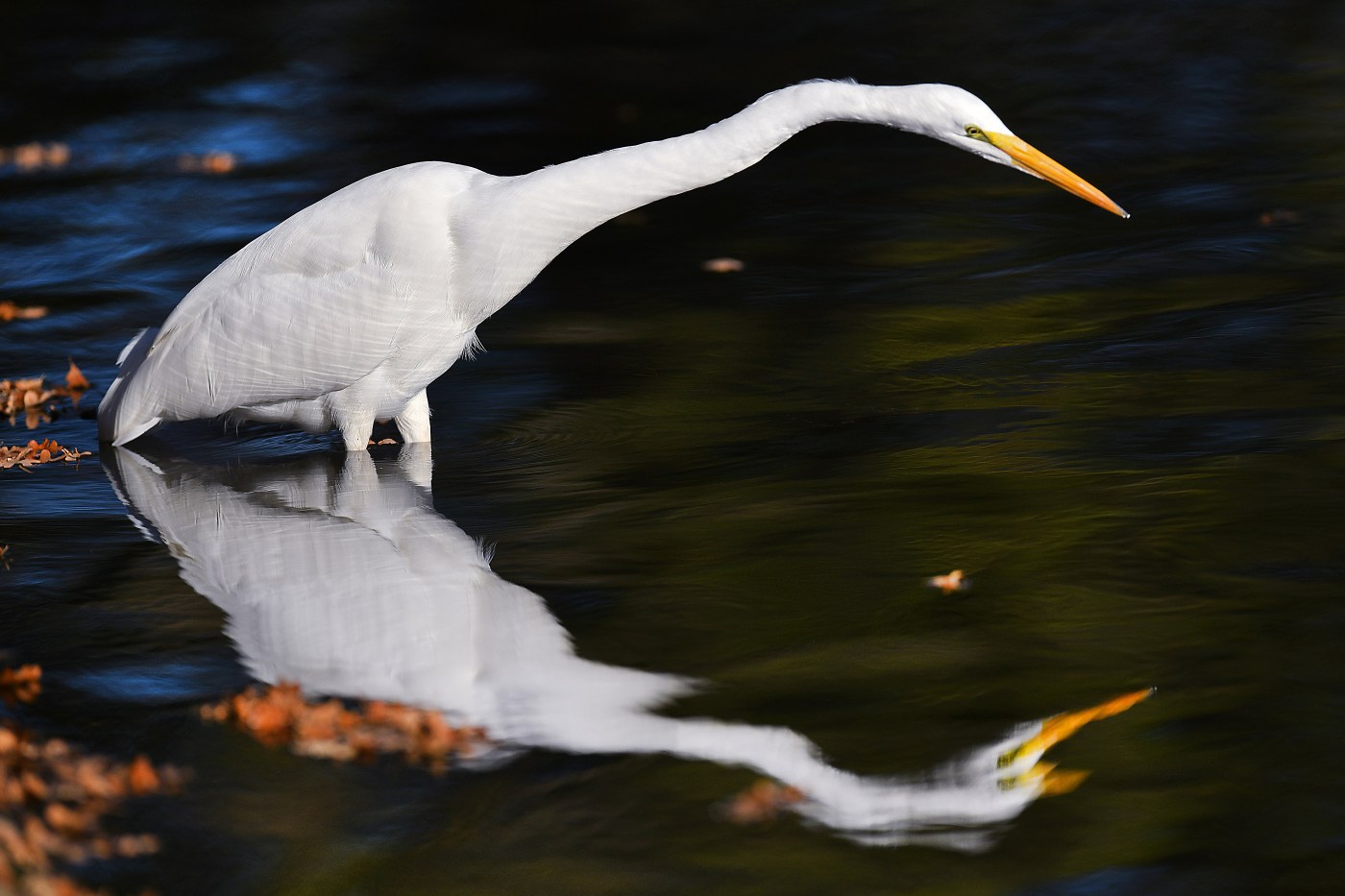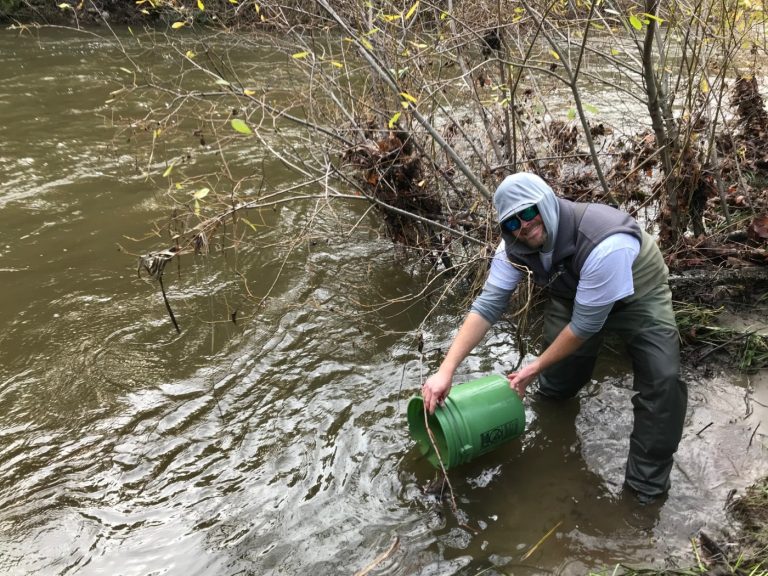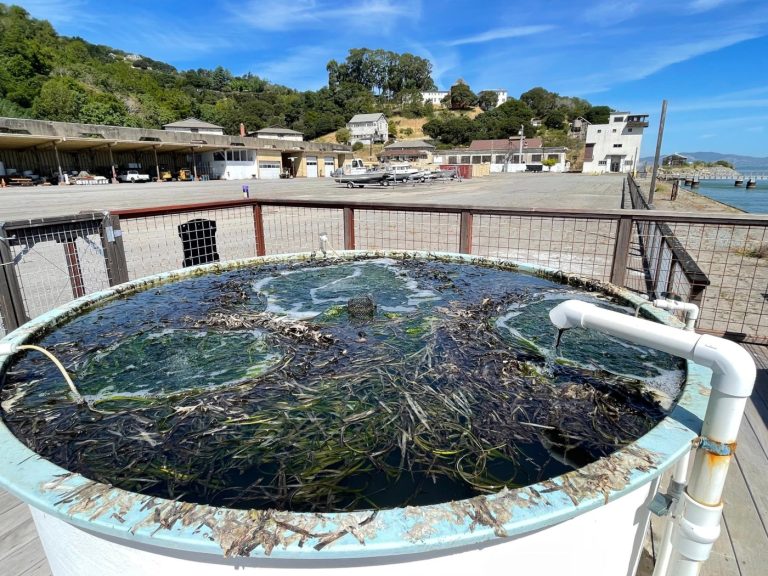Fall is a magical time to birdwatch in the Bay Area. It’s the peak of the songbird migration, the hawk migration and the ongoing shorebird migration. But how do you actually “watch” a bird? Where should you go? What should you look for? How do you use binoculars, anyway? (Hint: Look through the smaller holes.)
Experts from ornithological societies recently shared handy tips and favorite places for birdwatching around the Bay. Here are five excellent birding spots and what you can expect to discover there this fall.
How to get started
A leucistic acorn woodpecker at is observed at Bishop Ranch Open Space in San Ramon. (Courtesy Sharon Anderson)
Related Articles
Get to know the Bay Area birds of autumn
Why have bluebirds ignored my birdhouse for a decade?
Why do my cats find catnip calming instead of invigorating?
House readies to help bald eagle soar as national bird
How to feed birds without attracting squirrels
The easiest way to begin as a birder is to just start paying attention, says Matthew Tarlach, a member of the Mount Diablo Bird Alliance who leads birdwatching field trips around the East Bay. Unless you live in the densest of concrete jungles, you’ll see at least some species of birds in city parks and neighborhood trees.
From there, you can start trying to identify the birds you see. One tool is the Merlin Bird ID smartphone app, an initiative by the Cornell School of Ornithology that walks birders through a set of questions to help identify the bird they’ve seen. The app also allows users to identify a bird’s species based just on its song — and it’s pretty accurate. Check out Cornell BirdCast’s https://birdcast.info/ site, too, which uses weather data to make migration forecasts. Enter your address and prepare to be wowed with the number and types of birds flying by you every day.
Typically, people engage with birding from four perspectives, Tarlach says. Citizen science birders log which birds are seen when and where. Over time, this group-sourced data can be used to, for instance, track how birds are responding to climate change. There are people who enjoy birding for the beauty, and others who come for the competition, especially when rare species are in the area. (In August, a slate-throated redstart seemed to have strayed into San Francisco terrain; later this fall, it might be the clay-colored sparrow, a small brownish bird with an impressive call.) And then there are the social birders, people who enjoy connecting with the birding community and learning about a new landscape through its avian inhabitants.
Heather Farm Park, Walnut Creek
A western screech owl stares out from a tree nook along the Seaborg trail at Briones Regional Park in Martinez. (Courtesy Isaac Aronow)
This easily accessible birdwatching spot offers plenty to see, possibly because the pond there isn’t manmade or new – it’s featured in some of the oldest Spanish maps of the area dating to the 1830s, says Tarlach, who leads birdwatching walks there. On a recent walk, his beginning birdwatching group counted more than 30 bird species, including four types of warblers, plus Western tanagers and ring-necked ducks. In a few weeks, he’s expecting white- and golden-crowned sparrows to start arriving at the park to settle for winter. The birds spend their summers above the Arctic Circle.
“Their families have been coming here for a long time,” he says. “It’s fun to see them coming home.”
Details: Open 7 a.m.-9 p.m. at 301 N. San Carlos Drive, Walnut Creek; www.walnutcreekartsrec.org/parks-facilities.
Middle Harbor Shoreline Park, Oakland
A flock of longbilled curlews rest on the shoreline at sunset at Middle Harbor Shoreline Park in Oakland on Thursday, May 2, 2024. (Ray Chavez/Bay Area News Group)
Hidden in a windswept and industrial corner of West Oakland – with nifty views of huuuge shipping cranes loading huuuuger ships – is a restored wetland that’s perfect for spotting shorebirds. The park is shaped like a crescent, with an observation tower that overlooks central mudflats dotted throughout the year with all kinds of water lovers: cormorants, snowy egrets, surf scoters, buffleheads, brown pelicans and long-billed curlews, sticking their Slurpee-straw beaks into the grassy muck.
It’s a veritable amphitheater of bird action. “When the tide is out, there’s all that exposed mud rich in food, and you get an incredible diversity of shorebirds that come in to feed. And at higher tides, especially in winter, there’ll be ducks and geese and waterfowl out on the Bay there,” says Bruce Mast, an instructor with the Golden Gate Bird Alliance.
Meander on the flat paths toward the riprap on the southern shore and you might spot something rarer. “I’ve had a wandering tattler out there. They’re rocky shorebirds briefly here during migration, and in the East Bay, you might get only one or two a year,” says Mast. “They look like overgrown sandpipers – a foot tall, dull gray with yellow legs – and they’ll be probing around on mussels and barnacles when the tide is low enough.”
Details: Open daily at 2777 Middle Harbor Road, Oakland; portofoakland.com/community/waterfront-recreation.
Vasona Lake County Park, Los Gatos
SAN JOSE, CALIF. – OCT. 23: Children learn birdwatching at a Youth Science Institute field trip, Saturday, Oct. 23, 2021, at Alum Rock Park in San Jose, Calif. (Karl Mondon/Bay Area News Group)
This sunny 152-acre park has excellent riparian habitats with a large lake dammed on one side, big log-strewn areas, a scenic rocky-creek ecosystem and cottonwood and sycamore trees that birds love. It’s also good habitat for families, with picnicking and Frisbee spots and a miniature train that kids love to ride.
Vasona is one of the best locations in the South Bay to find warblers – small, colorful songbirds that typically fly in during the fall from eastern and northern America. “You might see a black-and-white warbler, Nashville warbler, hopefully a chestnut-sided warbler, maybe an American redstart,” says Matthew Dodder, executive director of the Santa Clara Valley Bird Alliance.
It can be challenging this time of year, because many warblers lose their distinctive colors. Try looking around at a variety of places to find them. “A lot are treetop species, gleaning insects and caterpillars from the upper part of trees. Some like to cling to trunks looking for ants and spiders in the bark, and a few like to be close to ground,” says Dodder. “And a lot are truly beautiful, even though they might lose some of their color.”
Details: Open until sunset daily at 333 Blossom Hill Road, Los Gatos; parks.sccgov.org
Martin Luther King Jr. Regional Shoreline, Oakland
Glenn Phillips, a Livermore native and the executive director of Golden Gate Bird Alliance, says this is his favorite spot in the Bay Area to catch migrating shorebirds and waterfowl returning each fall.
“You’re in the middle of this crazy urban place, and yet it has this amazing nature,” he says. “And great birds.”
Start at the end of the entrance road off Swan Way and you can do the full 2-mile loop, although Phillips says he always runs out of time, too busy watching the canvasbacks, northern pintails, scaups, goldeneyes, buffleheads, western grebes, godwits, curlews, sandpipers and dowitchers.
His favorite? The long-billed curlew, which you can watch forage with their gigantic curving bills.
The one rare bird Phillips is hoping to see this year?
“A short-eared owl,” he said. “We see them in the fall in grassland and inland. They used to be more abundant. Their habitat in the northern plains has been hurt by new farming techniques and their populations are down. Now they’ve become quite rare.”
Details: Open from 8 a.m. to 8 p.m. daily at Doolittle Drive and Swan Way in Oakland; ebparks.org/parks/martin-luther-king.
OAKLAND, CA – DECEMBER 17: A heron bird stands on a rock at Martin Luther King Jr. Regional Shoreline Park in Oakland, Calif., on Thursday, Dec. 17, 2020. (Ray Chavez/Bay Area News Group)
Coyote Hills, Fremont
Most of the same birds that can be found at Martin Luther King Jr. Regional Shoreline can be found here, but Phillips says Coyote Hills offers a whole different vibe.
“It may be the best birding destination in the whole Bay Area,” he says. “You feel like you’re not in the city anymore, because you’re not. You’re surrounded by this really rich land with so many birds. It feels like you’re stepping back in time.”
Details: Open from 8 a.m. to 8 p.m. daily at 8000 Patterson Ranch Road in Fremont; ebparks.org/parks/coyote-hills.
Canada geese walk on a field of mustard plants near the entrance to Coyote Hills Regional Park in Fremont, Calif., on March 20, 2023. (Dai Sugano/Bay Area News Group)












